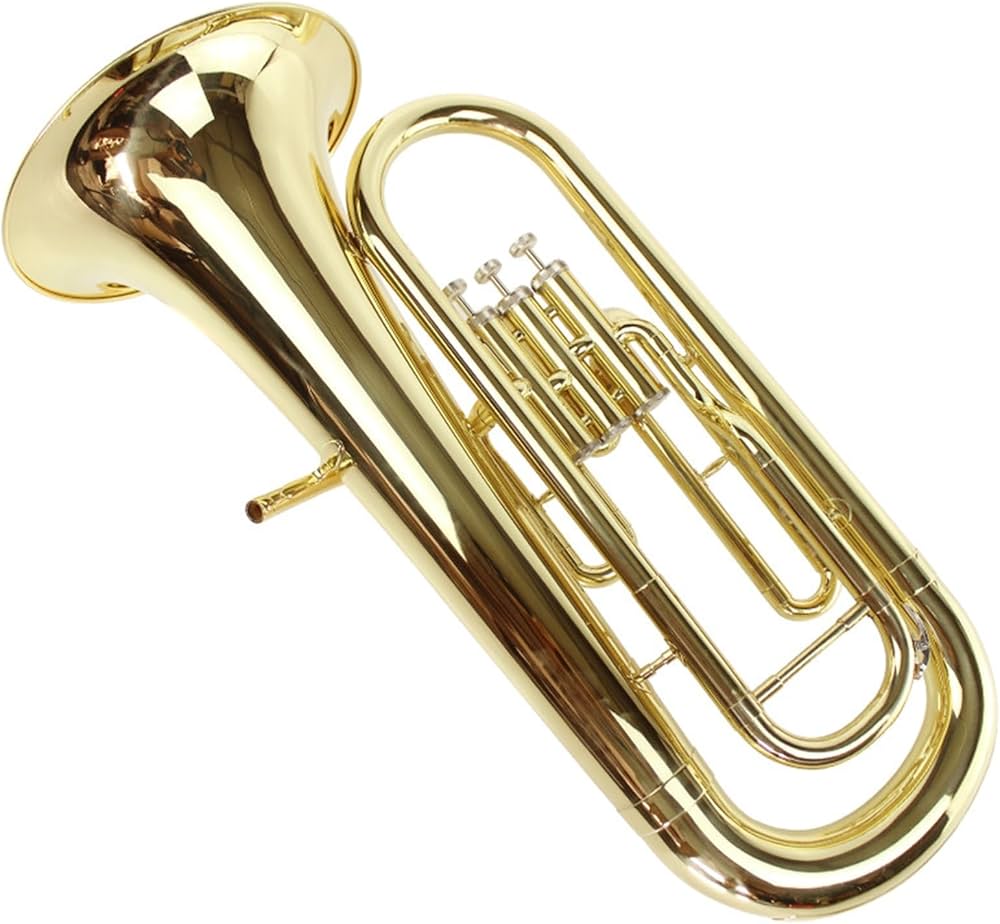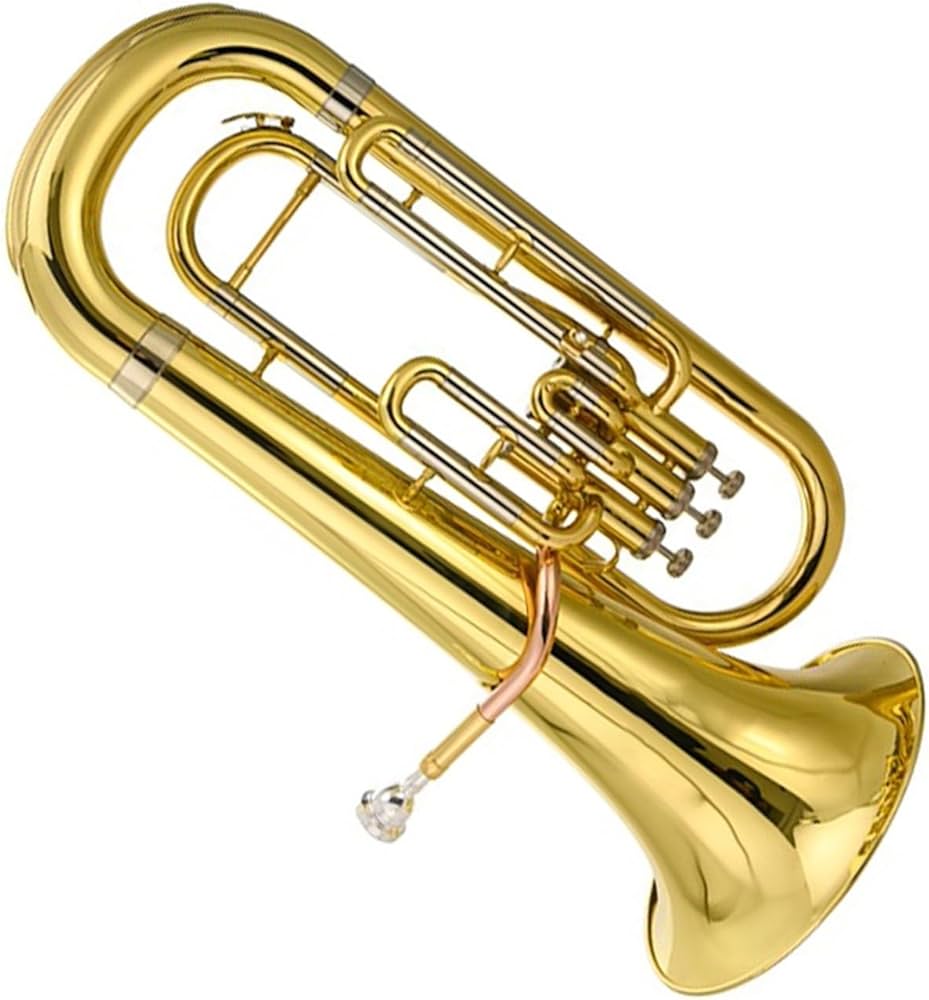History and Origins of the Euphonium
The history of the euphonium is a tale of gradual development and refinement, rooted in the broader family of brass instruments that includes the tuba, trombone, and French horn. Like many brass instruments, the euphonium’s development spans centuries, tracing its origins to earlier instruments that shaped its modern form.
The euphonium as we know it today evolved during the 19th century, though its ancestors can be traced back to the early days of brass wind instruments. One of the euphonium’s precursors was the “serpent,” a long, coiled instrument that was used in the 16th to 18th centuries. The serpent, which had a similar range to the euphonium, was primarily used in church music and military settings. Though the serpent was an important influence, it was replaced by the tuba and other more modern brass instruments over time.
The term “euphonium” itself derives from the Greek word “euphony,” which means “sweet-voiced” or “pleasant sound.” This name was chosen to reflect the instrument’s smooth, rich tone that contrasts with the sharper, more piercing sound of smaller brass instruments.
The euphonium emerged in its current form in the mid-19th century, when it was created by adding valves to the tuba family of instruments to make it more versatile and able to play higher ranges. By the mid-1800s, various versions of the euphonium were being produced, with some key modifications such as the addition of valves. These early euphoniums were designed to be played in brass bands, which were growing in popularity during this time. As the euphonium developed, it took on the characteristics that define it today—its conical bore, mellow tone, and substantial size. The euphonium gained even more prominence in the 20th century, becoming an essential part of brass bands, military ensembles, and wind orchestras. It also began to find its place in solo performances, where its rich tone and wide range allowed it to stand out as a melodic instrument. In the United States and the United Kingdom, brass bands, in particular, saw the euphonium grow in importance, with musicians like David Thornton and Steven Mead becoming influential in showcasing its capabilities.
How the Euphonium Works
The Mechanism of the Instrument
The euphonium operates on the same fundamental principles as other brass instruments. Its sound is produced through the vibration of the player’s lips in the mouthpiece, which creates a sound wave that travels through the instrument’s tubing and is projected through the bell. What sets the euphonium apart from other brass instruments is its unique design, which includes a conical bore, a set of valves, and a larger mouthpiece.
The Mouthpiece
The mouthpiece of the euphonium is an essential component that contributes to its rich, full sound. The euphonium’s mouthpiece is larger and deeper than that of a trumpet or cornet, allowing the player to produce a more resonant tone. The shape and depth of the mouthpiece help produce a smoother, warmer sound, which is why the euphonium is often described as having a more “mellow” voice within the brass family.
To produce sound on the euphonium, the player must buzz their lips into the mouthpiece, which causes vibrations that travel through the instrument’s tubing. The euphonium player must maintain proper embouchure to create a steady, controlled buzz, which allows the instrument to produce a clean and consistent tone.
The Tubing and Valve System
The euphonium features a system of valves, which are used to alter the length of the instrument’s tubing and, consequently, its pitch. Like the trumpet, the euphonium typically has three or four valves, although some models may have additional valves for greater flexibility. When a player presses a valve, it diverts the air through additional lengths of tubing, effectively lowering the pitch. Each valve corresponds to a different length of tubing, and combinations of valves allow the player to access a wide range of pitches.
What makes the euphonium’s valve system unique is its conical bore. Unlike the cylindrical bore found in instruments like the trumpet, the euphonium’s tubing gradually widens from the mouthpiece to the bell. This conical shape contributes to the instrument’s smooth, mellow tone, which is particularly noticeable in the lower and middle ranges.
The euphonium’s valve system is essential for accessing its full range of pitches, especially for notes that lie outside the natural harmonic series of the instrument. Pressing a valve lengthens the tubing, which lowers the pitch and allows the euphonium to play a wide variety of notes across its full range.
The Bell
The bell of the euphonium is one of the most important features that gives the instrument its distinctive sound. The euphonium’s bell is typically larger than that of a trumpet or cornet, contributing to its deep, resonant tone. The bell’s flared shape helps amplify the sound and project it outward, giving the euphonium its full-bodied and rich tone.
Because the euphonium has a larger bell and conical tubing, it produces a sound that is more focused and darker than other brass instruments. This characteristic allows the euphonium to blend smoothly with other brass instruments in a section, while also standing out as a solo instrument when needed.
Types of Euphoniums
Though the euphonium is a relatively standardized instrument, several types and variations cater to different musical contexts and player preferences. These variations may involve the number of valves, the construction material, or the specific tonal qualities of the instrument.
The Compensating Euphonium
The compensating euphonium is a more advanced version of the instrument that features a unique valve system designed to improve tuning and intonation. In a compensating euphonium, a set of additional tubing is engaged when certain valves are pressed, helping to maintain correct pitch and tuning, especially in the lower range of the instrument.
The compensating system is particularly useful for brass band musicians who require precise tuning in challenging musical passages. This design allows the euphonium to play more in tune across its full range, making it an ideal choice for more advanced players and professional brass band musicians.
The Non-Compensating Euphonium
The non-compensating euphonium is a more straightforward version of the instrument that does not feature the additional tubing found in the compensating model. While the non-compensating euphonium is less complex and more affordable, it is generally not as precise in terms of intonation as the compensating version. However, it remains a popular choice for students, beginners, and musicians who do not require the advanced tuning capabilities of a compensating euphonium.
The Double-Bell Euphonium
The double-bell euphonium is a rare variation of the instrument that features two bells, which can be used to produce different tonal qualities. The player can switch between the bells by using a mechanism built into the instrument, allowing them to create a wider range of sounds. The double-bell euphonium has become a collector’s item, and it is most commonly used by professional players in specialized performances. While the double-bell euphonium provides additional tonal versatility, it is not commonly used in standard brass band settings, as it is more of a novelty instrument. Nevertheless, it remains an intriguing piece for enthusiasts and professional players alike.
The Marching Euphonium
The marching euphonium is a modified version of the traditional euphonium designed for use in marching bands. This version of the euphonium is generally lighter and more compact, allowing for easier carrying during parades and performances. The marching euphonium typically features a forward-facing bell, which helps project the sound in an outdoor setting. While it shares many of the tonal qualities of the standard euphonium, the marching version is built for durability and portability in marching band settings.
Key Features of the Euphonium
The euphonium’s most distinguishing features are its mellow, warm tone, its conical bore, and its extensive range. Let’s dive deeper into these and other characteristics that make the euphonium a truly unique instrument.
Rich and Mellow Tone
The euphonium is most renowned for its rich, sonorous tone. Its deep, warm sound sets it apart from other brass instruments, making it an ideal choice for both melodic lines and harmonic support. The euphonium’s tone is often described as “velvety” or “smooth,” which is a result of its larger mouthpiece, conical tubing, and substantial bell. This allows the instrument to produce a sound that is both rich and resonant, but also warm and smooth, especially in the lower and middle registers.
Wide Range
The euphonium has a wide range, typically spanning from the low B-flat (two octaves below middle C) to a high B-flat (the second octave above middle C). This range allows euphonium players to explore both deep, resonant tones as well as brighter, more melodic passages in the upper register. Skilled euphonium players are able to utilize the full range of the instrument, making it an incredibly versatile tool for both solo and ensemble performance.
Versatility in Musical Settings
The euphonium’s unique sound and wide range make it a versatile instrument in many musical settings. It is a key member of brass bands and military bands, where it plays both a supporting and a solo role. In brass bands, the euphonium often plays counter-melodies or harmonies, blending seamlessly with other brass instruments. As a solo instrument, the euphonium is capable of performing both lyrical and dramatic passages, showcasing its expressive capabilities.
Excellent Intonation and Tuning
The euphonium is known for its solid intonation, particularly in the compensating models, which are designed to correct tuning issues that might arise in the lower register. Euphonium players can achieve precise pitch control across the instrument’s range, making it a reliable choice for both group performance and solo performances.
 Links
Links



















